#PIRATE MOVIE
Explore tagged Tumblr posts
Text
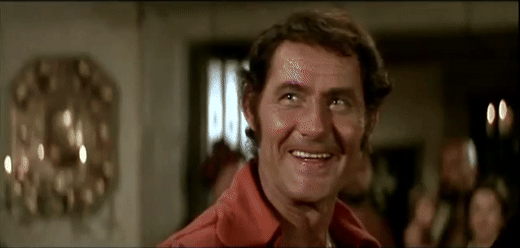
Swashbuckler (1976)
#Robert Shaw#Peter Boyle#sword fight#Captain Ned Lynch#Lord Durant#1970s#pirate movie#Jamaica#70s film
46 notes
·
View notes
Text
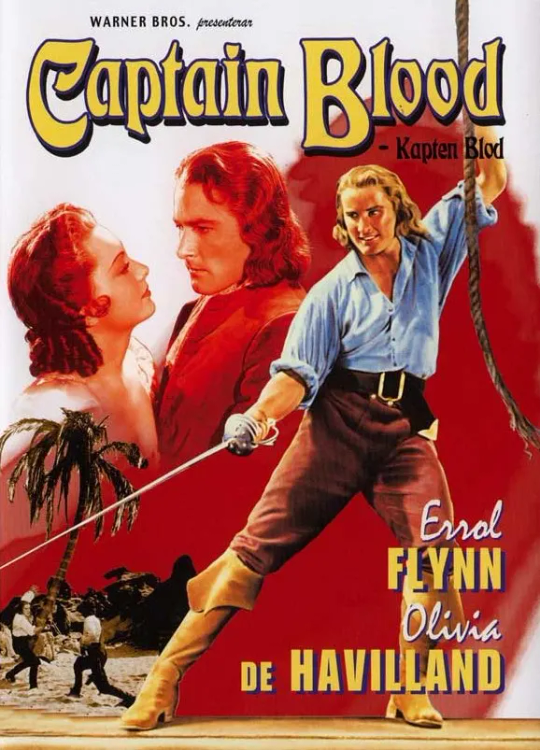







Captain Blood (1935) Directed by Michael Curtiz
Errol Flynn - Peter Blood Olivia de Havilland - Arabella Bishop Lionel Atwill - Col. Bishop Basil Rathbone - Levasseur Ross Alexander - Jeremy Pitt Guy Kibbee - Hagthorpe Henry Stephenson - Lord Willoughby
36 notes
·
View notes
Text
Action January II: Captain Blood (1935)

Part One: By the Sword
Fun fact about me: I am a non-classically trained fencer.
By which I mean I went through formal training as a child (starting at 6 or 7), then continued it sporadically through my youth and college. Kept up with it a little after college, but I'm no longer a fencer. Still, it was a pretty prominent part of my life, and one of the more bougie facts about me (of which there are admittedly many; I am, for example, struggling to not type bourgeoisie). I look back on it fondly, but it's not for modern-day me.
Still, I've always had a soft spot for swashbucklers, especially in film. Sure, traditional épée fencing doesn't resemble your typical swashbuckling film fight, even a little bit. Usually, épée with the fencing gear is put in a movie or TV show to demonstrate that the character or establishment practicing it is high-class or rich. Instead, I suppose cinematic swashbuckling is more similar to sabre fencing, which has a larger target zone than épée fencing, and usually involves grander movements...but even then, I've never seen any sabre fencer swing from ropes and rafters like, well...
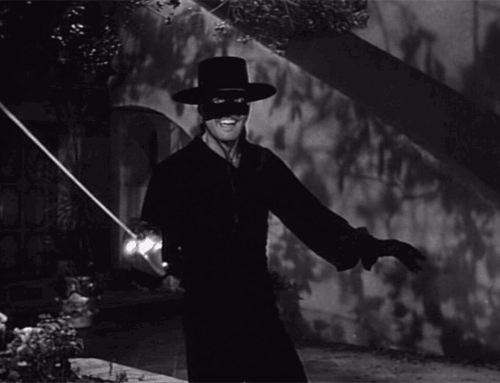
Zorro is a character that I've talked about before on this blog. I've also covered the swashbuckler briefly in that post, but let's get a little more comprehensive this time, shall we? Zorro is maybe the prototypical swashbuckler character, starting with Douglas Fairbanks' epic film The Mark of Zorro in 1920! Yeah, old as hell. He was daring, dashing, and debonair; dressed in black and fighting for justice to get the girl and save the day, armed with only a sword and his wit! The prototypical action hero! Throw in some great choreography and epic music, and voila! A swashbuckler! To put one together properly, we need:
A dashing hero, with devil-may-care attitude that fights for the moral right. If we're talking in DnD terms, you can call this person chaotic good alignment, usually. Swinging from the rafters, a sword in hand and often a smile on their face. And, of course, a romantic aim and goal.
Swordfighting. Kind of critical to the genre. Swashbucklers are films that use swordfights as the driver for the plot. While not every action sequence may involve a sword fight, the main hero is always either armed with their sword or looking for it. And then it's time for the climax, you better believe we've got a big-ass swordfight on our hands. The villain of the piece, at least one of them, should also have a sword in hand.
A sweeping score is a very typical piece of these films. Whether in the past or present, swashbuckling can't be done without an iconic leitmotif for the hero, and battle music times to the clashes of steel. Usually throw some brass or strings in there, and you have a swashbuckling score.
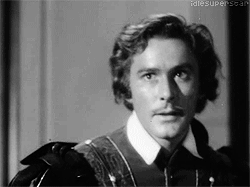
Now, of course, there are a lot of swashbucklers out there based on those definitions, and...yeah, there are a lot of swashbuckler films! While The Mark of Zorro is typically called the first swashbuckler, it's not the first film to involve narrative swordplay by any means. The Count of Monte Cristo (1908) is probably the first of those, but there are others like The Prisoner of Zenda or Kidnapped. You may also notice that some of the classic swashbucklers are based on classic literature, like those above, and like Cyrano de Bergerac, The Scarlet Pimpernel, The Man in the Iron Mask, and the most prominent of these...

It's funny, for a character best known for his archery skills, Robin Hood gets into a lot of swordfights. Some of the most iconic filmed swordfights come from the emerald archer from Sherwood, and for good reason! There have been countless adaptations of the original stories, which are crazy cinematic, and they all take place in medieval England, during a time period where swords were predominant weaponry. Combine that with the fact that Robin Hood is, in many retellings, a nobleman who would've been trained in fencing, and you have a natural swashbuckler setup!
And honestly, Robin Hood is sort of the perfect swashbuckler. A morally good hero fighting against the evil establishment, for his friends, contrymen, and the woman he loves. Epic music, daring setpieces, classic fights, a lot of swingin' rafters...yeah, it's perfect. And again, one day, I'll talk about The Adventures of Robin Hood from 1938; one of my favorite action films, and my favorite adaptation of Robin Hood for sure.
But there's another type of swashbuckler that's just as iconic as those listed above, also involving a setting conducive to sword-based action, but often with heroes that are...a little more morally grey.
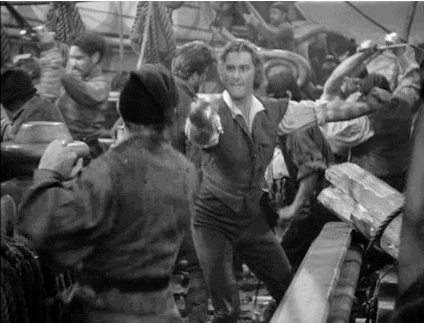
Pirate films are essentially a subgenre of the swashbuckler (yes, a subgenre of a subgenre of a subgenre), focusing on high-seas action rather than fighting in a hall or castle. The pirate film is a curious beast, appearing in film history in sporadic bursts, with no real period to call its own. They were popular from the '30s through the mid-'60s, had a tiny boom in the '80s, got badly nuked in the '90s, and then had another tiny boom in the '00s with the Pirates of the Caribbean franchise. They're always around, but never the first genre you'd think of when you think of action films.
Still, pirate films have an iconic feel to them all their own. The wind in your hair, the daring sword fights against a surly knave or an overzealous government stooge, depending on the nature of your morally dubious hero. Hell, maybe the hero has resorted to piracy after being wronged or lost at sea, and we're rooting for him and his lost honor. Either way, he's got an open shirt and a sword in his hand, and his crew are there to back him up (or betray him; again, depends on the narrative). You know a pirate film when you see one. And that's where I'm headed today: to the open seas with Captain Blood, starring an iconic action star of the 1930s and '40s. In fact, he's so iconic, almost every one of the above GIFs includes him.
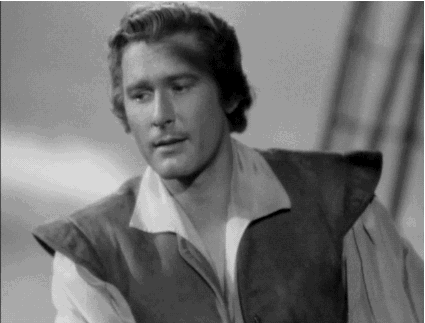
Errol Flynn is undoubtedly a major film figure of his day. He's also got a fascinating and...sometimes troubling personal history, putting him up there with some of the great Australian film actors in cinema. But as much as I'd like to talk about Errol Flynn (and I probably will later), I'd like to finally jump into the film that made him famous: Captain Blood, a 1935 film directed by Michael Curtiz, another interesting figure with some...interesting history with Flynn. Again, more later.
Flynn was an unknown before this role, and immediately became an audience and studio favorite, essentially succeeding Douglas Fairbanks as a films and action star. Only 26 at time this film came out, Captain Blood was the beginning of an often turbulent career for Flynn, who would die at only 50 years old. Again, more on him later. And so, without further ado...SPOILERS AHEAD!!!
Recap

It's 1685 in England, and there's a rebellion happening! Known as the Monmouth Rebellion, it involved the deposition of James II, after succeeding his brother as king of England, which was contested by Parliament and Protestants, as James II was a Catholic king. Anyway, during the rebellion, Doctor Peter Blood (Errol Flynn) is summoned to aid a friend injured in a skirmish. A retired adventurer and swashbuckler in his own right, Blood is determined not to re-enter the...fight...
Is this Commando? Like, where a retired hero is forced to come back to fight for his country, and won't come back until a personal tragedy or offense is done to him? You know, like Commando? Just calling it now, before it happens.
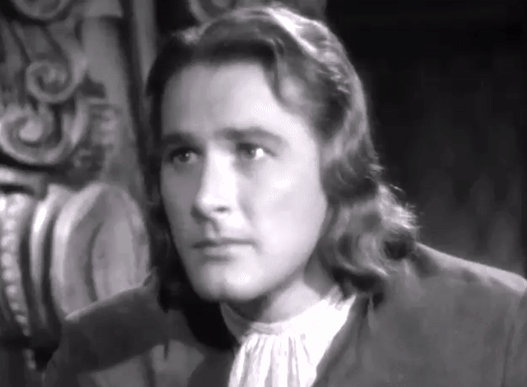
As Blood is helping his friend, he's taken away and sentenced by Judge George Jeffreys (Leonard Mudie), who accuses him of being a liar and traitor to the crown, despite his complete innocence. Imprisoned and set amongst a group of similar prisoners for months, he attempts to defend himself on the stand, only to condemn himself even further beneath a biased kangaroo court. And for the record, Flynn immediately proves why he's so beloved at this time. He's an excellent actor in this scene, and I immediately sympathize with Peter Blood.
Meanwhile, King James II (Vernon Steele) is convinced by his advisor to send the convicts to the West Indies as slaves, as actual slaves are too expensive, and these guys are free of cost. So, yeah, British monarchy not looking too great. In any case, we set to sea for the first time, in the belly of an unrealistically humane slave ship. In Blood's words, the King was "granted their lives in exchange of an uncertain death". And with that, Blood and the convicts are sent o Port Royal, in Jamaica.

The convicts are set for sale (hate it), and most of them are sold to Colonel Bishop (Lionel Atwill) and his niece, Arabella (Olivia de Havilland). When she observes Blood's rebellious nature at being inspected like cattle, she decides to keep him from working in the mines on her own spoiled whims. Blood's not a fan, and the two immediately clash. Which, obviously, means they're gonna fall in love by the end. Come on, we know how this goes.
Blood's sent to work on the plantation with Bishop's other slaves, on a grinding mill that loves like it's ripped out of Conan the Barbarian. We see the indignity of slavery through...white slaves. Yeah, trying not to think about it, since this is a thing that happened, but it's tough. Anyway, our traitors are taught a lesson about treason, as an escapee is branded on his fucking face, and the prisoners all say how much they hate the fucking King. Great job, James, really fanning the flames of patriotism there.
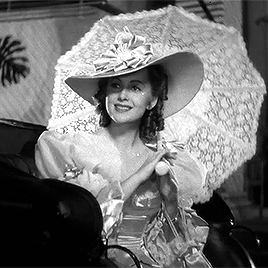
Meanwhile, the uncaring and selfish governor, Steed (George Hassell) is complaining of gout, and is in need of a physician. Knowing of Blood's former profession, Arabella recommends him as Steed's physician, and is mostly elevated from the role of slavery, which seems...insanely easy. Irritatingly easy, even. But whatever; at least he hasn't forgotten his friends, his actual station, or the fact that Arabella bought him for 10 goddamn shillings! He's still understandably bitter about that.
However, he's in very good favor with the governor for relieving his gout, unlike the previous doctors Bronson (Hobart Cavanaugh) and Whacker (Donald Meek), who attempt to plot to get rid of the much more competent Blood. He puts them in their place, but begins a plot of his own. With the other slaves arrested for treason, he plans an escape attempt from Port Royal, with the help of friend (and the guy who got him in this mess to begin with, Jeremy Pitt (Ross Alexander). However, in the process, Colonel Bishop suspects some kind of plan, which is only circumvented with the help of Arabella. In the process, however, Pitt is captured and flogged for questioning.
While his friend is getting horribly whipped by the Colonel on the stockades, Blood and Arabella flirt (as expected), although a kiss from Blood is received poorly due to his status, leaving the encounter on a sour note. Peter goes back to care for the Governor before their escape that night, then finds Jeremy at the stockades and cares for him as well. He's caught by the Colonel showing mercy, and is about to share Jeremy's fate when a ship attacks the port.
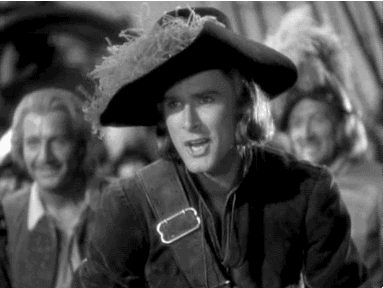
This ship belongs to the Spanish, and the sailors aboard lay waste to the port. It's at this point that the slaves see an opportunity, and make their way to the ships. They take over the Spaniard's ship, and wait until the morning to take out the returning Spaniard captain and soldiers. With navigator Pitt and new gunner Henry Hagthorpe (Guy Kibbee), the new crew sets sale and escapes, under the purview of the new Captain Blood.
Colonel Bishop, like...like a fucking idiot, sails out on a rowboat to thank the men, not realizing it's his own slaves. And then, when he finds out, he still intends to keep them as slaves. THEY HAVE A SHIP, DUDE! You're fucked. Instead of killing him, which they consider, they toss him overboard, and Blood's crew sets sail for the Caribbean Sea, leaving Arabella behind. They abandon their citizenship, and officially become pirates.

The crew of Blood becomes famed and infamous across the seas, to the irritation of King James II himself. With Governor Steed having lost both money from the Spaniard assault, and being unable to reign in Blood in the first place, his appointment as Governor is given to Colonel Bishop, who swears to take care of Blood once and for all. Arabella is conflicted about this, but she's shipped off to England along with Governor Steed.
On Tortuga, Blood signs a deal with another captain, the French Levasseur (Basil Rathbone), and the two become partner pirates. Later on, Arabella finishes her extended holiday in England, traveling alongside Lord Willoughby (Henry Stephenson), who has been tasked to take out Captain Blood. On their journey, they see Levasseur's ship, which attacks them and takes the passengers hostage on a nearby island. They are soon joined by a surprised Peter Blood and his crew, who pretends not to know her.
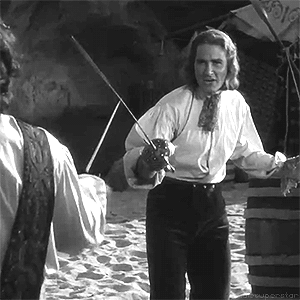
Blood and Levasseur engage in an argument, as one of the articles of their contract was that no female prisoners would be taken. As a compromise, Blood pays for her ransom, both to save her and as payback for his purchase of her many years ago. This still enrages Levasseur, who wanted Arabella for himself, and he forgoes his honor to challenge Blood to a fencing duel. Fun fact, by the way: Basil Rathbone was an actual fencer, classically trained, and far better than anyone he ever fenced with on-screen, Flynn included. But, since he always played the role of a villain and cad, he was always forced to lose. And this fight is no exception.
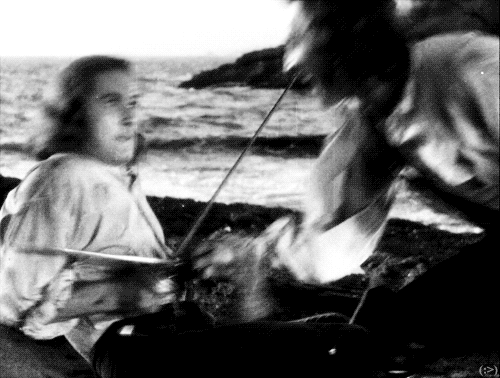
Levasseur is killed by Blood...which is crazy, since he's Basil fucking Rathbone, and he was in this movie for maybe 5 minutes altogether as essentially a cameo, but...c'est la vie, et la mort. Arabella and Willoughby are brought on board, only for Arabella to angrily reject him. And yes, she's absolutely a goddamn hypocrite, but she's not fully unjustified. She puts Blood down as a beast like any other pirate (unfairly, of course), and Blood angrily rebukes her in turn. Even then, he plans to bring the two hostages back to Port Royal, where they are certain to die.
Willoughby and Arabella speak, where he convinces her that Blood's genuinely not a dick, and tells her that they're headed to Port Royal. At the same time, Blood's crew refuses to sail to Port Royal, officially acting in mutiny against Blood. And Blood...gracefully surrenders his command of the ship, admitting his affections for Arabella to be driving him against logic. And that ironically turns the crew back to Blood's command. I can't tell if that was a sign of their actual bond, or some straight gatekeeping-girlbossing-gaslighting from Blood, but...yeah, they're still going to Jamaica.

As they approach Port Royal, though, they find it being attacked by two French ships. Willoughby, finally being able to speak with Blood, informs him that France and England are at war. To their surprise, though, Governor Bishop isn't present, nor is the English fleet, since they're out chasing pirates. And so, the only ship to defend Port Royal against the French, is...well, Blood's.
It's then that Willoughby finally reveals his purpose for seeking Blood and his crew: the King has pardoned him. Obviously, they're not a fan of King James II given what he'd done to them, and refuse the offer. But then, Willoughby reveals the other political change: James II is out as King. With that knowledge, Blood and his men decide to fight for the English Navy, and for the new King William III.
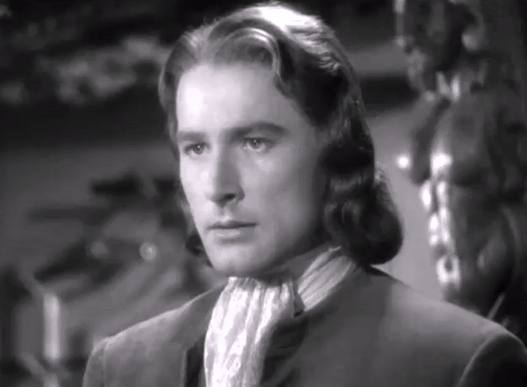
Arabella is shuttled ashore, while the ship sails under a French flag to disguise themselves. They easily ambush the French ships attacking the Port, wrecking one and causing it to fucking explode. Honestly, it's pretty sick. The other ship mounts a harsher assault, and Blood's crew is forced to abandon ship. Instead, they simply take the French ship for themselves. And as the Captain swings over, you realize something: this is the prototypical pirate movie.
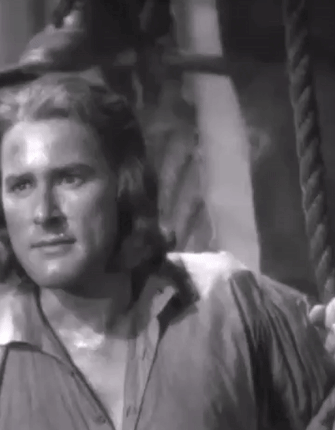
Yeah, OK, earlier films like The Black Pirate, as well as later ones like The Sea Hawk and Treasure Island, would be a major framework for pirate films in the future. But good goddamn, if this doesn't feel like a pirate movie, I don't know what does. The score is sweeping, the action is epic, and it's honestly just fun. And the most ironic thing is, this is happening at the point in the film when they aren't technically pirates anymore! Hilarious.
Anyway, Blood's crew wins the day for England, only for the Governor to finally return from his futile journey. Arabella, seeing Blood return and knowing her uncle's hatred of him, tries to warn him away while admitting her love to him. But to the surprise of her and her uncle, Bishop is officially deposed as Governor for abandoning his post in times of war to pursue his vendetta, even though he knew Willoughby was coming. He's at the mercy of the new Governor: Doctor Peter Blood. Honestly, it's funny as fuck. Blood bids him "Good morning, Uncle.", and the film comes to a close.
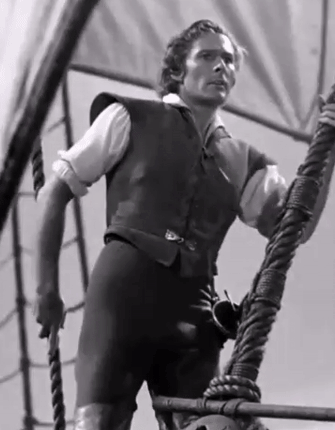
That's it for Captain Blood! Gonna do an old-fashioned review set-up and have a separate post for the Review! And that's because, while the review won't be terribly long...I would really like to talk about the man, the myth, the alcoholic legend himself, Errol Flynn.
See you in the Review!
#user365#365 days 365 movies#365 movies 365 days#365days365movies#365 movie challenge#365 movies a year#action january#action#action movie#swashbuckling#pirate movie#pirates#captain blood#michael curtiz#errol flynn#olivia de havilland#basil rathbone#action genre
13 notes
·
View notes
Text










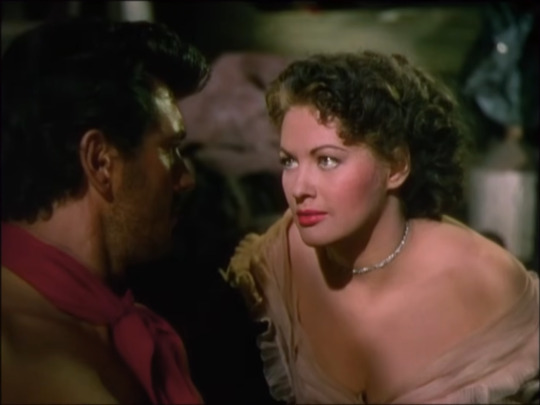

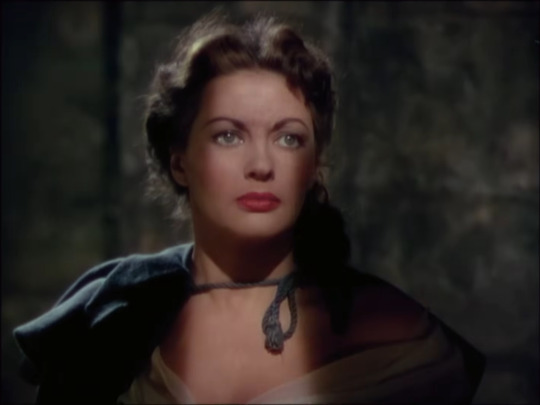
Yvonne De Carlo in Sea Devils (1953)
#yvonne de carlo#sea devils#1953#1950s film#50s movies#costume design#historical costuming#I don't know if this is remotely accurate costuming lol but there's some interesting stuff going on#michael goodliffe#raoul walsh#pirate movie#spy movie#napoleon movie#historical movie#swashbuckling#actor posts
6 notes
·
View notes
Text

pirates and their unconventional weddings (marines crashed it seven times)
#I just think they deserve a corny ass movie rock and roll wedding#yes nami officiates barbosa style#one piece#one piece fanart#luzo#zolu#monkey d. luffy#roronoa zoro#luffy#zoro#my art#straw hat pirates#I GOT SO MANY ASKS TO PUT THIS ONE ON HERE GIKSKFKD YOU GUYS MOVE FAST. wish is my command
15K notes
·
View notes
Text
"Romantic Antic"

The neckerchief is left in one panel -- oversight on the silhouette.

#Archie Comics#Archie Andrews#Veronica Lodge#Ol' Betsy#Movie theater#Pirate movie#Neckerchief#Silhouette#Joe Edwards#1970#Hearts#Cary Dimples#Swash buckler vs swashbuckler
1 note
·
View note
Text
hey so since we're talking about how awful the minecraft movie looks we're all going to agree not to go see it in theaters right? not even to hatewatch it? we all are in agreement that its a soulless cash grab movie, so we all know that the only way to stop them from making more like it is to give them no cash to grab, right?
yes this includes watching it for the bit. yes this includes bringing your friends to go make fun of it. yes this includes just watching it out of curiosity.
do Not go see this shit in theaters. do Not give them your money. they dont care whether you enjoyed it or not, they only care about what number the box office gives them. so make sure the box office cant give them shit.
#dragons chatting#minecraft movie#im so serious about this by the way#if youre gonna watch it out of curiosity Pirate That Shit#if you dont know how to find a friend who does#do Not give them your fucking money
14K notes
·
View notes
Text
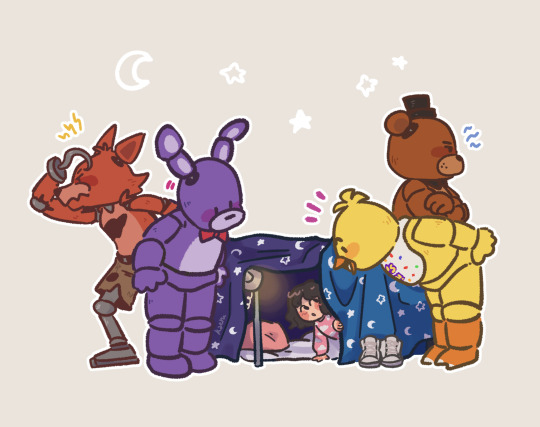

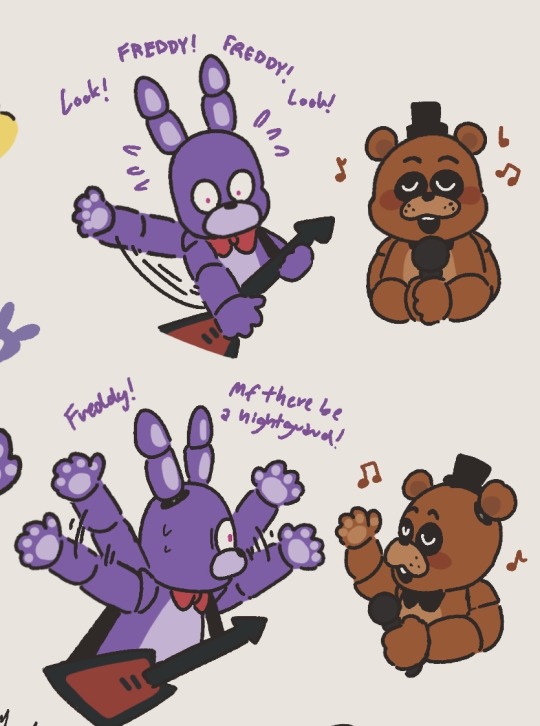
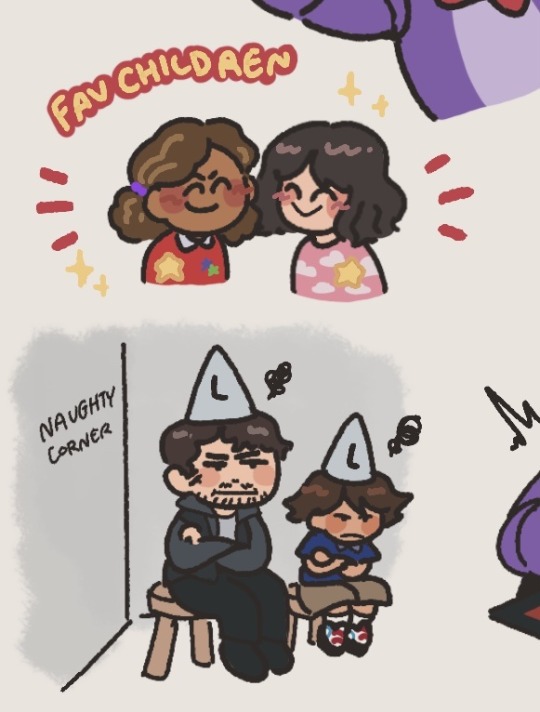
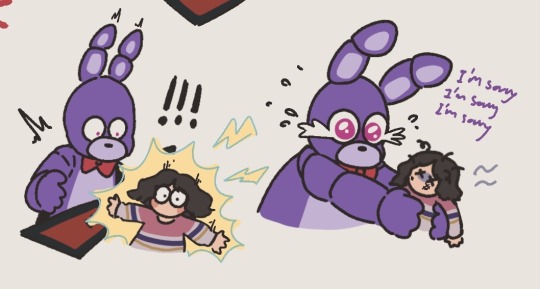
Hi fnaf movie dump but it’s mostly bonnie and abby
#stupid ass rabbit i hate to admit he was so silly he stole the whole movie#also i know he’s blue but i have an attachment of drawing him ourple ok#abby on the other hand i would die for her#fnaf#fnaf movie#fnaf fanart#five nights at freddy's movie#five nights at freddy's#freddy fazballs#freddy fazbear#chica the chicken#bonnie the bunny#foxy the pirate#mike schmidt#abby schmidt#oh and featuring cassie and greggory🥰🥰#fnaf sb#fnaf ruin dlc#fnaf sb cassie#fnaf sb gregory#also i have been hiding freddy fazballs tag in every fnaf post#idk if you guys notice
49K notes
·
View notes
Text



she's everything
47K notes
·
View notes
Text





The Black Pirate (1926)
12 notes
·
View notes
Text
Action January II: Captain Blood (1935)
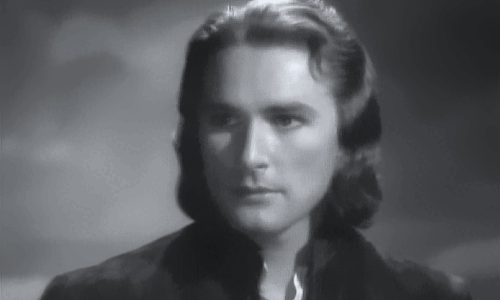
Part Two: A Colorful Fragment in a Drab World
When you think of the Golden Age of Hollywood, it's hard to get more notable than Errol Leslie Thomson Flynn at the height of his career. One of the most prominent leading men of the time period, succeeding Douglas Fairbanks and alongside Clark Gable, he was a mountebank of talent and action. At least...that was a public image of his. The actual Errol Flynn? Genuinely a drunken disease-ridden criminal who maybe exemplifies the idea of dividing the art from the artist. 'Cause, uh...wow. Not a good person, was Flynn.
If you do not care about Errol Flynn, skip to the break; I'll put my five-point review down there so time isn't wasted. I just really want to talk about Errol Flynn. Ready? OK.
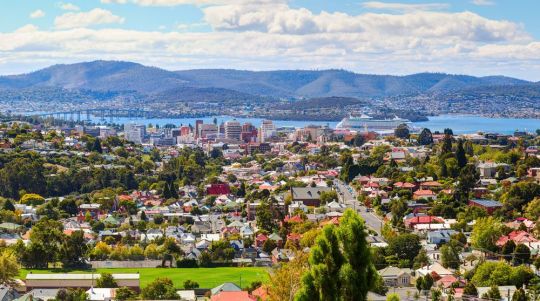
Born in Hobart, Tasmania on June 20, 1909, Errol Flynn grew up in a middle class household. His father was a biology professor, while his mother was...well, in his autobiography, Flynn would say that she had "an itch to live - perhaps too much like my own." And given what we know about Errol's "itches", that's saying something. There's some speculation that she was sleeping with a local movie theater manager,leading to Flynn hanging out there often and watching a lot of movies. Is that true? Well, Flynn is a...somewhat unreliable narrator, so take his statements with a grain of salt. He also claimed that he and his mother were descended from some of the soldiers that participated in the famous mutiny on The Bounty, but that's probably not true. However, keep that factoid in mind for later.
Early life was complicated for Flynn, and bad habits emerged early. By the time he was 17, he'd been expelled from 4 schools for inappropriate acts (of violent and sexual natures); he'd joined a local gang; he'd already started his collection of sexually-transmitted diseases with gonorrhea (and he was, uh, quite the collector); and he was working in New Guinea. In New Guinea, he...um...

OK, look here's what you gotta know about Flynn: dude is nasty, in a lot of ways. Most of those ways are, unfortunately, sexual in nature. Since I'd like to be sensitive to the sensibilities of readers, I won't go into every nitty gritty detail. So, starting with his New Guinea adventures, let's just say that he killed a number of native people during colonization efforts, and then did that other classic thing that colonizers have done, historically. You know, that thing that goes with pillaging?
And to be clear, Flynn wasn't ashamed of this. In his autobiography, My Wicked, Wicked Ways, he describes one of the native New Guineans he encounters in...very unfortunate detail. Flynn was a nasty kid, before and after his acting career began. Speaking of which, while he was working in Australia (after fleeing from New Guinea for murder, etc.), he was spotted by director Charles Chauvel, and was offered to be in a film about the mutiny on the Bounty. Crazy coincidence, huh? Errol accepted, and that was his first film, In the Wake of the Bounty, in 1933. It's now disappeared into obscurity, but that was the beginning.

Flynn's career began mostly in the UK, where he acted as extras while getting professional training. Then he threw a stage manager down a flight of stairs and was fired from his repertory company. Because that's Errol Flynn, apparently. He worked on a few more films, married actress Lili Damita, and eventually got the attention of Hollywood. After a couple of small roles, Michael Curtiz tapped him as a 4th choice for his new movie, Captain Blood. Not only was this the first film with Curtiz and Olivia de Havilland (19 at the time), but it was a smash hit. Flynn was a star, the new Douglas Fairbanks!
1936: he works with Curtiz and Olivia again in The Charge of the Light Brigade. 1937: A dramatic role in Green Light, then another swashbuckler in The Prince and the Pauper, a melodrama in Another Dawn, and a comedy in The Perfect Specimen (with Curtiz again), all before acting as a war correspondent during the Spanish Civil War. And then, finally, in 1938, he reunites with Curtiz, Havilland, and Basil Rathbone in my favorite of his films: The Adventures of Robin Hood. And if Flynn was famous before, then that movie really did it.

In the meantime, he gets married to actress Lili Damita in 1935, and this would be the first of 3 marriages. And lemme tell you, it would end tragically for Flynn, hilariously for everybody else. From 1935 to 1939, Flynn's career would take off, and he would work with Curtiz and Havilland a few more times, but things would start to change at this point. See, starting all the way back in The Charge of the Light Brigade, Curtiz and Flynn had regular disagreements. In that film, 25 horses actually died under Curtiz' direction, and the animal-loving Flynn got into a legit fist-fight with his director. And this was the second of seven collaborations together. The two hated each other, but they knew good filmmaking when they saw it. Curtiz' career, by the way, includes Casablanca, just so you know what caliber of director we're talking about.
Flynn's career continued, as did his contentious nature. The Sea Hawk in 1940 continued his career climb, as World War II was in full swing. At the same time, he got badly slapped by co-star Bette Davis (yes, THAT Bette Davis) in the face in The Privates Lives of Elizabeth and Essex during an argument in a scene, which he wrote off as "unrequited romantic interest" (ugh); he had more arguments with Curtiz on Virginia City in 1940, and tried to get him off his own picture; and he co-starred with no-name actor Ronald Reagan in Santa Fe Trail, which is probably the only notable thing that dude ever did.

And this, of course, is when the health problems and drinking started. He'd contracted malaria when he was younger in New Guinea, which damaged his heart significantly. And oh, God, the drinking. Flynn was a notorious womanizing, chain-smoking drunk, especially throughout the 1940s. He'd had affairs with everybody (a habit so famous, it's the origin for the phrase "in like Flynn"), and would regularly get into physical fights with everyone else. In the process, he would greatly expand his collection of diseases. By 1942, he had chronic tuberculosis, recurrent malaria, gonorrhea, syphillis, and a host of unrecorded STDs. This, combined with heart damage and back pain, made him ineligible for service during World War II, which had many believing he was a draft dodger (since studios didn't want word of their big star having that many STDs). And that's not all!
See, Lili's getting sick of the whole "constant cheating and STD" thing, so she files for divorce. Said divorce had insane conditions by today's standards, and would essentially had Lili rolling in Errol's money FOR LIFE, while leaving Errol with far less money for the rest of his days. How could this get worse? Easy; he was being sued for statutory r*pe that year as well, and nearly resulted in a 25-year prison sentence. He was acquitted, because Hollywood's always been bullshit, but his reputation was...well, frankly, it was fucked. And at this point, Flynn was only 33 years old. Jesus Christ.

After this, Flynn would never fully recover. Oh, he was still in movies, but his drinking and partying continued, and his reputation somehow got even worse. He would show up blasted to sets, ending his relationships with many directors. His appearance started taking a nosedive due to his health and behaviors. He got married again, in 1943 to Nora Eddington, somehow, but Nora later regretted that marriage. Scandals continued, like the time newspapers found out he'd installed one-way mirrors in his mansion's bathrooms in order to look at his female guests secretly (ew. EW.), and he added hepatitis to his collection of diseases.
Marriage #3 comes along in 1950, and Flynn moves to Europe in 1954 for his films. He's there for a few years, until finally getting a call back in 1957 to star in an adaptation of Hemingway's The Sun Also Rises. Flynn idolized Hemingway, and actually wanted to be an author just like him. Might have accomplished it, if not for the EVERYTHING ELSE he was doing. Still, he accepted the role, which cast him as a pathetic drunk has-been, past his years and prime. What I'm trying to say is, he crushed it. Hard.

Flynn's back, baby! And now, he's being typecast as a drunk. Which, again, is what he was at this point. Also, I should clarify, alcoholism is absolutely a disease, and my issues with Flynn have nothing to do with the fact that he was an alcoholic. However, he was constantly drunk, that's just a fact. His success in The Sun Also Rises revitalized his career in the late 1950s, and things were looking good. He even started up his old journalism ambitions when he traveled to Cuba during Castro's revolution, and was the only journalist there when Castro won.
In 1959, though, Flynn's financial difficulties had become too much, even with his career rebirth. He went to Canada to sell a yacht to a guy, then flew back to Los Angeles on October 14. In the process, his back and legs started acting up. Not unusual for him. The doctor in LA noted that Flynn could barely walk up the stairs, then gave him some Demerol, a massage, and good conversation. Flynn said he "felt ever so much better", and the doctor left. A 17-year-old girl that had been traveling with him (yeah, that sounds horrible) went in to check on him 20 minutes later.

Errol Flynn died on October 14, 1959, at the age of 50. His cause of death was found as a heart attack from coronary thrombosis, atherosclerosis, and severe cirrhosis of the liver, amongst the STDs that plagued him his entire life. Flynn was buried with six bottles of his favorite whiskey at Forest Lawn Memorial Park Cemetery in Glendale, California. He had once said he hated this place, and never wanted to be buried there, so you gotta imagine that his current marriage wasn't going great either. Jesus.
But even after he died, Flynn's legacy continued to degrade. His autobiography came out, which didn't really help him image much. His work as a war correspondent was put into question as illegitimate, and thought to be used only to promote his films. That 17 year old that discovered his death revealed that yes, that sentence was as creepy as it sounded, and Flynn never learned his FUCKING LESSION. He was also possibly outed as bisexual, which is obviously fine (assuming the bisexual community wants to claim this asshole at all), and I only point this out to say that he was described as "super-straight" by Iron Eyes Cody. And who's Iron Eyes Cody? Trust me. Look him up. You don't wanna trust a goddamn word that dude said.

So, with all of that bullshit said and finally done...Errol Flynn was still an excellent actor. Yeah, I honestly mean that. IN fact, I'll elaborate in a minute here in the review below. So, read on if you're interested in that. And if not, honestly, watch Captain Blood and The Adventures of Robin Hood yourself, and make your own opinions. Just saying, he could act. Separate the art from the artist, people.
Review

Cast and Acting: 9/10
Just to get our leading man out of the way, Errol Flynn is fantastic in this movie. I mean it; for a guy who'd barely been in movies, and for this being his first leading role, he knocks it out of the park. Suave and debonair, defiant and headstrong when he needs to be, and someone you're charmed by as much as the characters on screen are. Plus, the swashbuckling is fun to watch, and credit should go to Flynn for some of that. Genuinely a star in the making; just forget all that other stuff from above, OK?
And everybody else? Olivia de Havilland, who's only 18 during filming, by the way, is also great in this movie. And again, this is one of her first films. Crazy, huh? Her role is uncomplicated, but she plays it very well! Basil Rathbone isn't in here for long, but he's a scene-stealer...partially because his French accent feels forced, and he's maybe a little over the top. Still, extremely fun to watch. Same could be said for Lionel Atwill, although he sort-of just drops off in the middle of the picture, when he could've been a real commanding antagonist. Missed opportunity, that one. As for the pirate crew, like Ross Alexander and Guy Kibbee, they're not bad! Meant in some cases to be comic relief, which is done well, but also portrayed as a loyal and faithful crew. Throw all of these performances together, and you get my final score. Solid all around, with a little scenery-chewing here and there.

Plot and Writing: 8/10
Honestly, this is both a standard swashbuckling plot (man of high-standing gets plunged into low-standing, then fights his way back to prowess via sword and fisticuffs), but also very different in some ways. It's based off of a novel by Rafael Sabatini, and certainly has a memorable and easy to describe story. However...and this is a soft however...Blood's gonna win. It's not the least predictable plot in the world, since you know Blood's gonna win and get the girl in the end. It also has a surprisingly bloodless ending, all things considered. Yeah, I know there's the battle with the French in the end there, but only one named cast member (Basil Rathbone) actually dies. It's fun to watch and easy to recall, but...kinda toothless in the end. Also, Blood is a bit of a Gary Stu most of the time, which isn't the best character work you can do.
Writing by Casey Robinson, though, is still fantastic. This is a SOLID adaptation of the book, from what I can tell, and Robinson manages to spice up a standard plot with some entertaining and engaging writing throughout. Honestly, this is a fun movie, and the writing helps with that quite a bit. Even got the Oscar nomination that year for Best Screenplay, but lost to The Informer. In fact, it technically wasn't officially nominated by the committee, but was instead nominated by write-in. That is how popular this film's writing was.

Direction and Cinematography: 9/10
Michael Curtiz, frankly, is a legend. And sure, I can't say this is a groundbreaking film in terms of direction in some ways, but good goddamn, does Curtiz still do an excellent job. This is especially notable when looking at the action scenes, like the beach swordfight, or the siege on the French ships (as seen in the GIF below). Seriously, though, this is a great-looking film, both due to legendary director and legendary cinematographers Ernest Haller and Hal Mohr. The former is best known for Gone With the Wind (I hate that movie, but it's admittedly gorgeously shot), while the latter is known for The Phantom of the Opera and...The Jazz Singer. Ooh. Yikes. Moving on!

Production and Set Design: 9/10
Again, kind of standard fare for the time period in some ways, but still a great looking production! You feel like you're on a ship or tropical island for most of the film, despite the entire film being made in California. That ending scene with the French ships? 2,500 extras were in that sequence, making it one of the biggest films ever made at that time. This is impressive production, including the prop work and...well, OK, one problem. The costumes are mildly anachronistic. It's nothing crazy, but keep in mind that this film is meant to take place in the 1650s. With that in mind, this feels far more like a film from the 1800s instead. This is a minor nitpick, but a nitpick nonetheless. Frankly, I've really had to try and find flaws with some of this stuff, because this film is genuinely great.
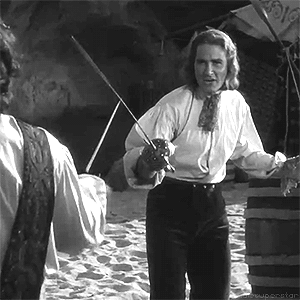
Music and Editing: 9/10
Music here is by Erich Wolfgang Korngold, another film legend and notable composer. His career very much followed Errol Flynn, as this was his first huge picture (not counting 1933's A Midsummer Night's Dream), and he would also score for The Adventures of Robin Hood, The Sea Hawk, and The Private Lives of Elizabeth and Essex. This booming brass score is your stereotypical swashbuckler tune, meaning that Korngold helped create that stereotype in the first place. It's iconic, it's memorable, and it makes for solid background in a action scene. Even did that thing where the sword-clashes are timed with music sometimes! Again, classic.
George Amy is our editor for this picture, and he's a legend in his own right. A powerhouse for Warner Brothers, Amy was a favorite of Michael Curtiz, and ended up editing the majority of his films (but not Casablanca, funnily enough). He definitely does well here, although I felt like one or two sequences could use a little trim here and there. Nothing really felt unnecessary, but there could have been a little something different in the near-mutiny sequence, for example. That sequence is maybe the weirdest in the film for me, as Blood sort-of gaslights the crew into following him into certain fucking death. Again, kind of a nitpick for me, but it did affect how I saw Blood, and maybe could've been changed to adjust the pacing of the scene.

Verdict: 88%
Pretty sure I've hurt some critic's feelings with that number, so I feel the need to clarify something: this movie's goddamn great. It's the progenitor of the swashbuckling genre for a reason, after all. This is a crazy fun film, but I won't give it an excuse because it's a classic. But would I watch this movie again? Absolutely. Like I said, a hell of a lot of fun.
Time for another classic action-adventure movie to continue the classics train, but let's jump forward a decade for this one, huh? Post World War II, classic director, and a precursor to the true action genre. And as always, one that's been on my list for a long time.

Next: The Treasure of the Sierra Madre (1948); dir. John Huston
#user365#365 days 365 movies#365 movie challenge#365 movies 365 days#365 movies a year#365days365movies#action january#action#swashbuckling#action movie#pirate movie#errol flynn#captain blood#michael curtiz#olivia de havilland#basil rathbone#biography#action genre
4 notes
·
View notes
Text
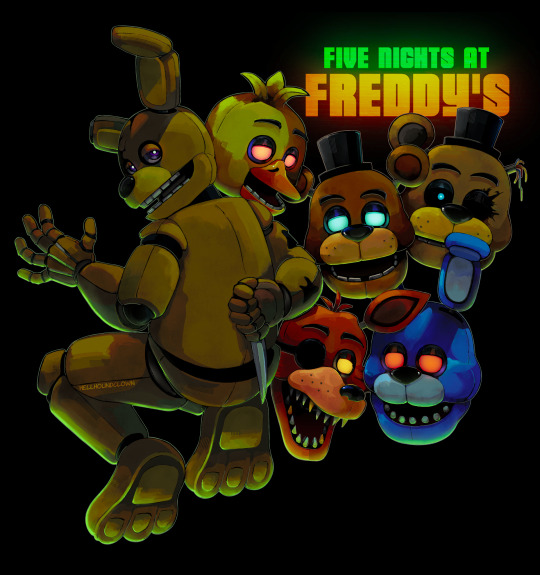
i really enjoyed the movie ^_^
#fnaf#fnaf movie#five nights at freddy’s#springtrap#spring bonnie#steve raglan#william afton#freddy fazbear#bonnie the bunny#chica the chicken#foxy the pirate#foxy the pirate fox#golden freddy#fnaf fanart
25K notes
·
View notes
Text
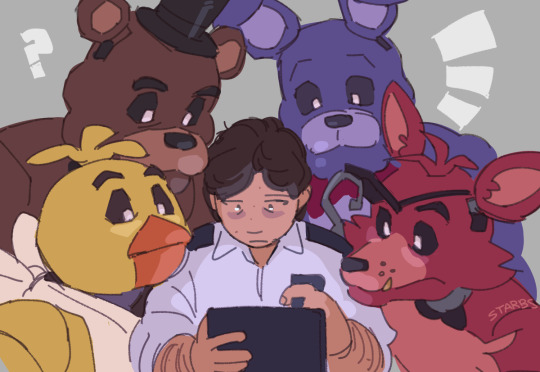
#fnaf movie#freddy fazbear#foxy the pirate fox#chica the chicken#bonnie the bunny#mike schmidt#fnaf#five nights at freddy's#starbsart
21K notes
·
View notes
Text

Every FNAF artist goes through this..
#myart#chloesimagination#comic#fnaf#five nights at freddy's#fnaf fanart#fnaf movie#abby schmidt#mike schmidt#foxy the pirate#mangle#fnaf 2#fnaf 2 movie#unserious comic time#LISTEN this idea came to me and it made me laugh#and that was enough to make it in full pff#Yknow that turning red scene#yeah this comic is like that#this might be a deep cut too for those who remember these times#Mike just wanna see Abby’s new art but she rather keep it to herself pff
4K notes
·
View notes
Text

Classic Sonic, Sonic and Shadow pirates!?


#sonic the hedgehog#artists on tumblr#sonic fanart#sonic fandom#shadow the hedgehog#fanart#medibandpaint#sonadow#sonic and shadow#sonic movie 3#sonic boom#sonic x shadow generations#pirate sonic#pirate shadow#repostthisifulovesonic
3K notes
·
View notes
Text
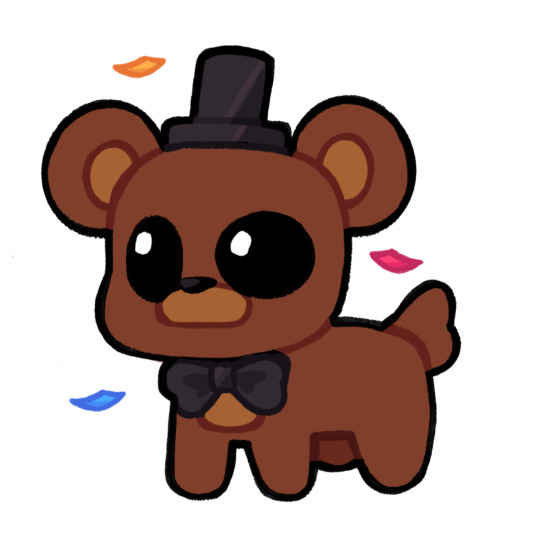

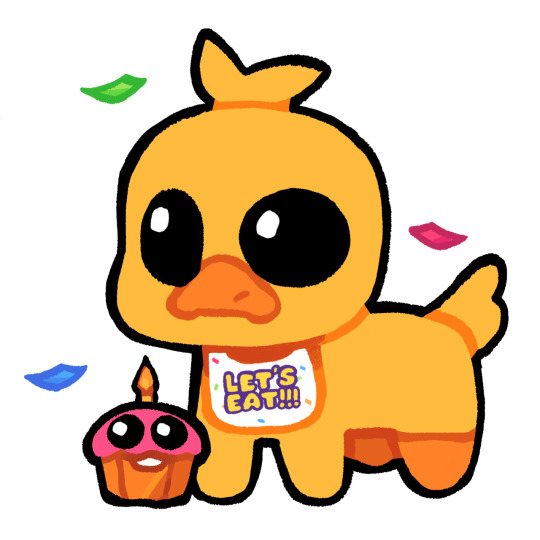
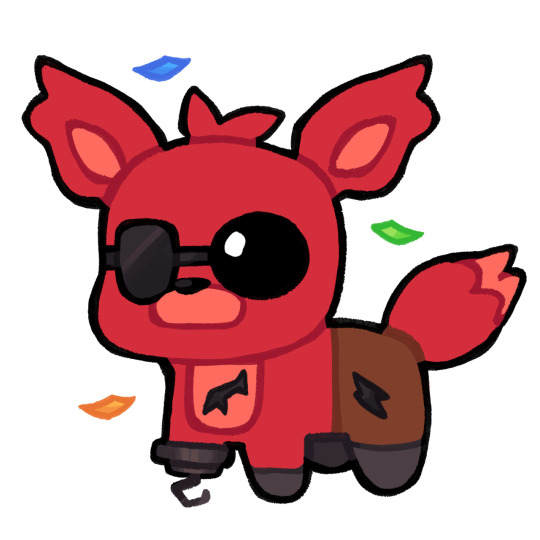
i regret to inform you that i have tism-ed them all
#fnaf#wren’s art#five nights at freddy's#fnaf 1#freddy fazbear#chica the chicken#bonnie the bunny#foxy the pirate#fnaf movie#fnaf art#fnaf fanart#freddy fnaf#fnaf freddy#chica#chica fnaf#fnaf chica#bonnie#bonnie fnaf#fnaf bonnie#foxy#fnaf foxy#foxy fnaf#artists on tumblr#art#digital art#fanart#illustration#fnaf 1 art#fnaf 1 fanart#fnaf 1 freddy
7K notes
·
View notes